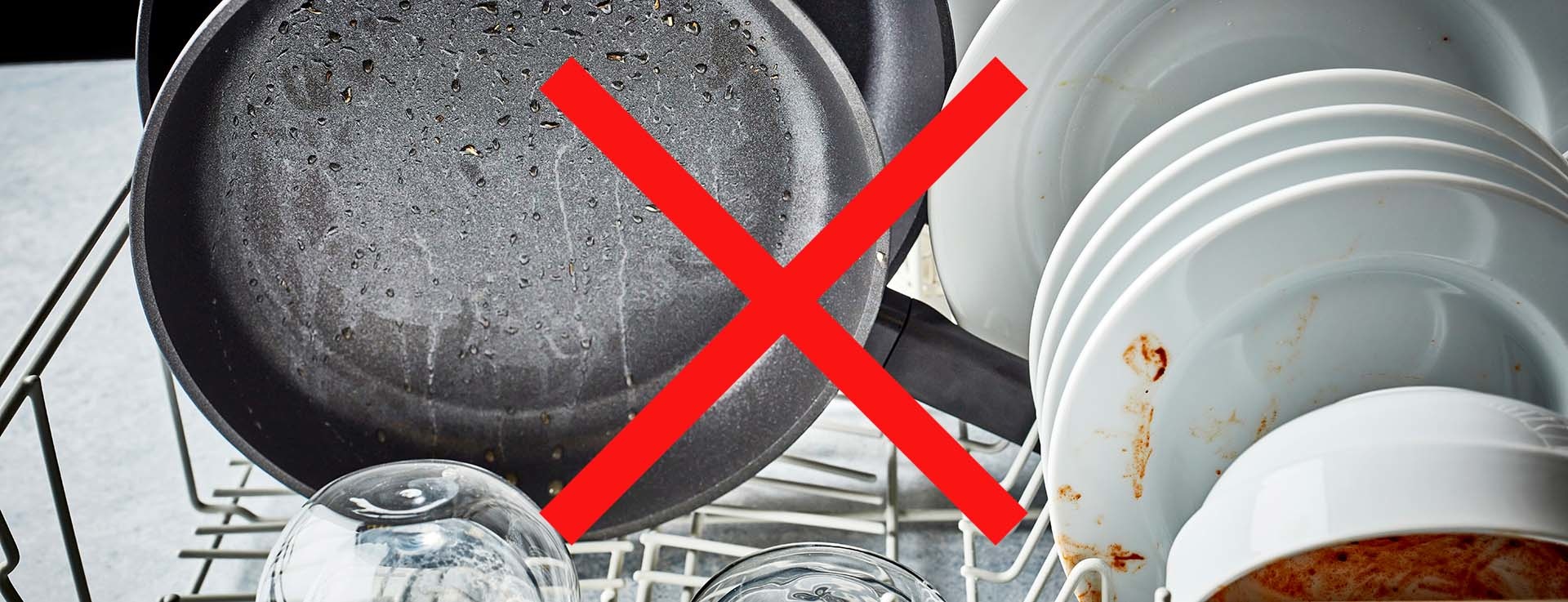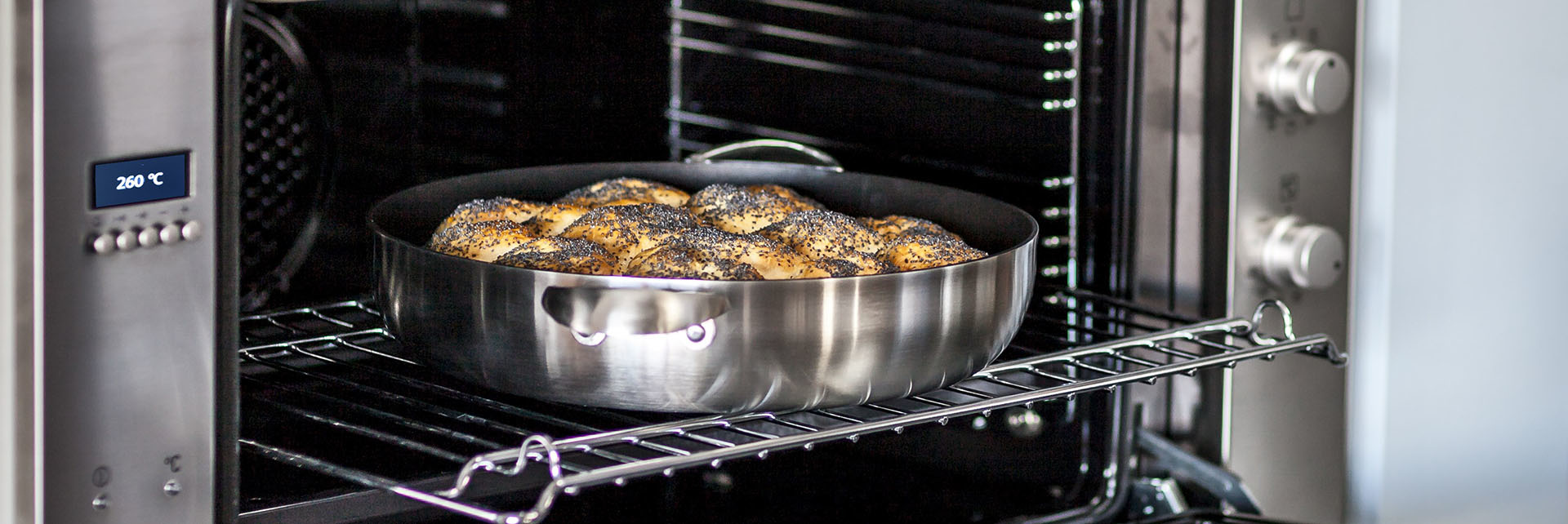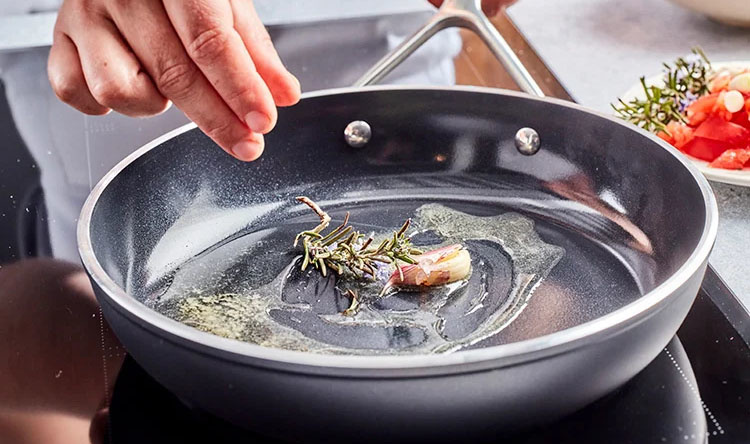How to care for your non-stick pan
A non-stick pan never lasts forever. To make it last for as long as possible, there are some important things to take into account
Do I need to treat a non-stick pan before the first use?
No. A new non-stick pan is ready to go. Although obviously it's good practice to rinse and clean a new pan before you first use it. A non-stick pan doesn't need to be seasoned, like a carbon steel or (light weight) cast iron pan. On the contrary, seasoning or polymerized fat is one of your non-stick coated pan's main enemies.
Cleaning
Always clean your non-stick pan thoroughly after each use, but don't put it in the dishwasher. Hot water, dishwashing liquid and a brush or a sponge (no scouring pad or metal sponge) will help degreasing the pan and preventing accidental seasoning next time you use it, which will eventually render your non-stick coating impossible to clean.
Dishwasher detergent nowadays is very aggressive and will make your non-stick pans wear down a lot quicker, shortening the lifespan substantially.

Never put your non-stick frying pans in the dishwasher.
Tools
Don't use any sharp objects (especially knives and forks) and be very careful when using metal utensils. Better yet, avoid using them altogether. Wooden or silicone spatulas are softer materials and the best choice for use in a non-stick pan. The ultra strong and durable Stratanium and Stratanium+ coatings made by Scanpan can also be used with metal utensils with minimal risk, but we would still recommend using gentler alternatives for a maximum lifespan.

Wooden and silicone spatulas are the best choice for use in a non-stick pan.
Temperature
Avoid overheating your pan. Of course it's ok to heat up your pan to a nice frying temperature, but temperatures above 230 °C (440 °F) will make the coating wear down a lot quicker and extreme and prolonged overheating can even release pieces of the coating from the pan. Scanpan's CTX, HaptIQ and TechnIQ ranges are especially heat resistant and can safely be heated up to 260 °C (500 °F).
To prevent overheating make sure to always add oil, butter and other ingredients in time and turn down the heat or induction setting when the pan has reached its desired temperature (keeping it at the same setting will usually keeping heating up the pan more and more. This obviously depends on the pan's heat retention and especially the amount of cold ingredients and liquids added to the pan.
It's always better to allow any frying pan to heat up slowly: to save the non-stick coating (if there is one), to prevent warping or deforming and to make sure the heat can be distributed evenly.
NEVER use the highest induction setting or booster function for any of your frying pans!

Scanpan's CTX, HaptIQ and TechnIQ ranges are even heat resistant and oven safe up to 260 °C (500 °F).
Do you want to use a frying pan at extremely high temperatures, for searing meat or other ingredients, flambéing, broiling or dry roasting seeds or nuts, make sure to use a stainless steel, carbon steel or cast iron frying pan instead.
Do these instructions apply to ceramic frying pans as well?
Yes, definitely. Non-stick frying pans with a ceramic coating (like Demeyere's Alu Plus and Alu Comfort ranges) should be treated with the same care as regular PTFE-coated pans. Perhaps even more.
PTFE is non-stick because of its chemical properties, whereas ceramic material can be made non-stick because of its smooth surface. When this surface starts to wear down and deteriorate, because of grinding or, more often, heat, the pan can start losing its non-stick properties quite rapidly. When that happens, a ceramic pan's decline is not as gradual as a PTFE-based one, but rather steep.

Ceramic non-stick pans also need to be treated with care and consideration.

 Frying pans & Sauté pans
Frying pans & Sauté pans Non-stick
Non-stick Stainless steel
Stainless steel Carbon steel
Carbon steel Cast iron
Cast iron Cooking pots
Cooking pots Demeyere Silver
Demeyere Silver Scanpan Impact
Scanpan Impact Scanpan Fusion 5
Scanpan Fusion 5 Habonne Royal
Habonne Royal Korkmaz Proline
Korkmaz Proline Korkmaz Perla
Korkmaz Perla Stellar Eclipse
Stellar Eclipse Sauteuses
Sauteuses Dutch ovens
Dutch ovens Chasseur
Chasseur Lava
Lava Victoria
Victoria Other
Other Grills & Grill pans
Grills & Grill pans Woks
Woks Carbon steel & cast iron
Carbon steel & cast iron Stainless steel
Stainless steel Non-stick
Non-stick Kettles
Kettles Fondue
Fondue Tajines
Tajines Pressure cookers
Pressure cookers Smoking pans
Smoking pans Poffertjes pans
Poffertjes pans Lids
Lids Splatter screens
Splatter screens Miscellaneous
Miscellaneous Paella
Paella Japanese knives
Japanese knives Kai Shun Classic
Kai Shun Classic Kai Shun Classic White
Kai Shun Classic White Kai Shun Premier
Kai Shun Premier Kai Shun Premier Minamo
Kai Shun Premier Minamo Kai Shun Pro Sho
Kai Shun Pro Sho Kai Kinju & Hekiju
Kai Kinju & Hekiju Kai Seki Magoroku KK Yanagiba
Kai Seki Magoroku KK Yanagiba Kai Seki Magoroku Kaname
Kai Seki Magoroku Kaname Seki Magoroku Migaki
Seki Magoroku Migaki Kai Seki Magoroku Redwood
Kai Seki Magoroku Redwood Kai Seki Magoroku Shoso
Kai Seki Magoroku Shoso Kai Wasabi Black
Kai Wasabi Black Kai Specialties
Kai Specialties Miyabi 7000 D
Miyabi 7000 D Miyabi 4000 FC
Miyabi 4000 FC Miyabi 800 DP
Miyabi 800 DP Miyabi 6000 MCT
Miyabi 6000 MCT Miyabi 5000 MCD
Miyabi 5000 MCD German knives
German knives Wüsthof Classic
Wüsthof Classic Wüsthof Classic Ikon
Wüsthof Classic Ikon Wüsthof Ikon
Wüsthof Ikon Wüsthof Epicure
Wüsthof Epicure Wüsthof Gourmet
Wüsthof Gourmet Burgvogel Oliva
Burgvogel Oliva Robert Herder
Robert Herder French knives
French knives Elephant ****Sabatier forged stainless steel pakkawood
Elephant ****Sabatier forged stainless steel pakkawood Elephant ****Sabatier forged stainless steel olivewood
Elephant ****Sabatier forged stainless steel olivewood Elephant ****Sabatier forged carbon steel pakkawood
Elephant ****Sabatier forged carbon steel pakkawood Elephant ****Sabatier forged carbon steel olivewood
Elephant ****Sabatier forged carbon steel olivewood Elephant ****Sabatier stamped stainless steel
Elephant ****Sabatier stamped stainless steel Laguiole en Aubrac Gourmet
Laguiole en Aubrac Gourmet Laguiole en Aubrac Classique
Laguiole en Aubrac Classique Pallares Solsona
Pallares Solsona Carbon steel kitchen knives
Carbon steel kitchen knives Stainless steel kitchen knives
Stainless steel kitchen knives Cleavers
Cleavers Steak knives
Steak knives Folding knives
Folding knives Steak knives
Steak knives Pallares Solsona
Pallares Solsona Wüsthof
Wüsthof Laguiole en Aubrac
Laguiole en Aubrac Kai / Shun
Kai / Shun Saladini
Saladini Laguiole Style de Vie
Laguiole Style de Vie Other
Other Honing and sharpening
Honing and sharpening Whetstones
Whetstones Sharpening rods
Sharpening rods Honing steels
Honing steels Knife sharpeners
Knife sharpeners Accessories
Accessories Accessories
Accessories Knife guards
Knife guards Knife magnets
Knife magnets Knife blocks
Knife blocks Knife bags
Knife bags Bread knives
Bread knives Cleavers
Cleavers Knife sets
Knife sets Simple kitchen knives
Simple kitchen knives Folding knives
Folding knives Victorinox
Victorinox Spyderco
Spyderco Böker
Böker Coutellerie G.R.
Coutellerie G.R.  Laguiole en Aubrac
Laguiole en Aubrac Cheese knives
Cheese knives Oyster knives
Oyster knives Miscellaneous
Miscellaneous Stellar Poise
Stellar Poise Graters, shavers, mandolines
Graters, shavers, mandolines Mandolines
Mandolines Microplane Master
Microplane Master Microplane Premium Classic
Microplane Premium Classic Microplane Gourmet
Microplane Gourmet Microplane Professional
Microplane Professional Other Microplanes
Other Microplanes Other
Other Whisks
Whisks Strainers & Colanders
Strainers & Colanders Spatulas
Spatulas Stainless steel
Stainless steel Silicone
Silicone Wood & Pressed wood
Wood & Pressed wood Plastic
Plastic Mortars & Pestles
Mortars & Pestles Tongs & Tweezers
Tongs & Tweezers Kitchen shears
Kitchen shears Garlic presses
Garlic presses Mills & Grinders
Mills & Grinders Peugeot Paris
Peugeot Paris Peugeot Paris Chef
Peugeot Paris Chef Peugeot ParisRama
Peugeot ParisRama Peugeot Paris Rouge Passion
Peugeot Paris Rouge Passion Peugeot various
Peugeot various Zassenhaus
Zassenhaus Brushes
Brushes Ladles & Serving spoons
Ladles & Serving spoons Nutcrackers
Nutcrackers Peelers
Peelers Oyster, lobster, snail
Oyster, lobster, snail Mashers
Mashers Skimmers / frying scoops
Skimmers / frying scoops Funnels
Funnels Ice cream scoops
Ice cream scoops Pizza shovels & Pizza stones
Pizza shovels & Pizza stones Can openers
Can openers Squeeze bottles
Squeeze bottles Meat mallets
Meat mallets Skewers
Skewers Miscellaneous kitchen aids
Miscellaneous kitchen aids Tortilla presses
Tortilla presses Baking tins & molds
Baking tins & molds Springform pans
Springform pans Quiche & flan tins
Quiche & flan tins Bundt pans
Bundt pans Cake & bread tins
Cake & bread tins Muffin trays
Muffin trays Madeleines, savarins, angel food
Madeleines, savarins, angel food Non-stick
Non-stick (Anodized) aluminum
(Anodized) aluminum Silicone
Silicone Cast aluminum
Cast aluminum Ceramic
Ceramic Baking trays
Baking trays Pastry rings
Pastry rings Small baking molds
Small baking molds Baking cups
Baking cups Paper Panettone molds
Paper Panettone molds Chocolate
Chocolate Polycarbonate molds
Polycarbonate molds Silicone molds
Silicone molds Miscellaneous chocolate tools
Miscellaneous chocolate tools Chocolate food coloring
Chocolate food coloring (Cookie) cutters
(Cookie) cutters Cutter sets
Cutter sets Cookie cutter sets
Cookie cutter sets Individual cookie cutters
Individual cookie cutters Fondant cutters / modelers
Fondant cutters / modelers Piping bags & nozzles
Piping bags & nozzles Sets
Sets Piping bags
Piping bags Round piping nozzles
Round piping nozzles Star piping nozzles
Star piping nozzles Miscellaneous
Miscellaneous Accessories
Accessories Mixing bowls
Mixing bowls Rolling pins
Rolling pins Bread
Bread Dough scrapers
Dough scrapers Palette knives
Palette knives Modeling tools
Modeling tools Mats, paper and foil
Mats, paper and foil Acetate foil
Acetate foil Silicone mats
Silicone mats Cooling racks
Cooling racks Brushes
Brushes Turntables
Turntables Cake servers
Cake servers Cake cutters / knives
Cake cutters / knives Candles
Candles Cake boxes
Cake boxes Other
Other Coloring powder
Coloring powder Gel colors
Gel colors Chocolate colors
Chocolate colors Liquid colors
Liquid colors Color spray & Velvet spray
Color spray & Velvet spray Edible markers
Edible markers Flavors
Flavors Glitter & decorations
Glitter & decorations Fondant & Marzipan
Fondant & Marzipan Misc. ingredients
Misc. ingredients Sugars and sugar substitutes
Sugars and sugar substitutes Gold and silver leaf
Gold and silver leaf Ravioli stamps
Ravioli stamps Ravioli molds
Ravioli molds Pasta wheels / rollers
Pasta wheels / rollers Rolling pins
Rolling pins Pasta makers
Pasta makers Various
Various Casseroles
Casseroles Roasting trays
Roasting trays Terrines
Terrines Thermometers
Thermometers Measuring jugs
Measuring jugs Scales
Scales Kitchen timers
Kitchen timers Measuring cups & spoons
Measuring cups & spoons Other
Other Japanese tableware
Japanese tableware Gift sets
Gift sets Bowls
Bowls Salad bowls
Salad bowls Plates
Plates Chopsticks
Chopsticks Tea
Tea  Cutlery
Cutlery Stellar Rochester
Stellar Rochester Stellar Sterling
Stellar Sterling Teapots
Teapots Salad bowls
Salad bowls Salad servers
Salad servers Butter dishes
Butter dishes Butter knives
Butter knives Heim Söhne spoons
Heim Söhne spoons Trivets and coasters
Trivets and coasters Glasses
Glasses Serving trays
Serving trays Other
Other Percolators / moka pots
Percolators / moka pots Bialetti parts
Bialetti parts French presses
French presses Milk frothers
Milk frothers Coffee grinders
Coffee grinders Tampers
Tampers Espresso tools
Espresso tools Milk jugs
Milk jugs Coffee filters
Coffee filters Wine tools
Wine tools Waiter's friends / corkscrews
Waiter's friends / corkscrews Decanters
Decanters Wine coolers
Wine coolers Other
Other Cocktail tools
Cocktail tools Misc. bar tools
Misc. bar tools Aprons
Aprons Kitchen towels
Kitchen towels Oven mitts & pot holders
Oven mitts & pot holders Other
Other Wood
Wood Plastic
Plastic Pressed wood fiber
Pressed wood fiber Wood oil
Wood oil



